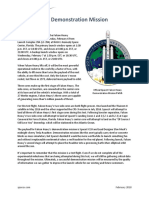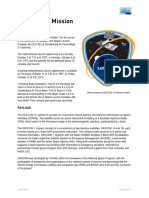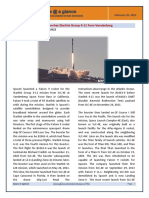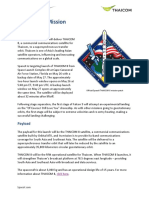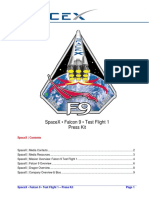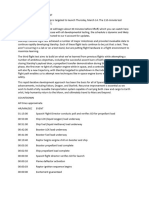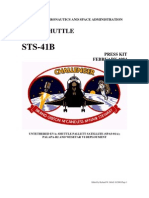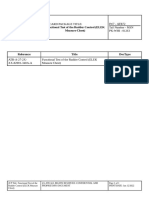Professional Documents
Culture Documents
SpaceX Arabsat 6A
SpaceX Arabsat 6A
Uploaded by
Jaime Jarauta GasteluOriginal Description:
Copyright
Available Formats
Share this document
Did you find this document useful?
Is this content inappropriate?
Report this DocumentCopyright:
Available Formats
SpaceX Arabsat 6A
SpaceX Arabsat 6A
Uploaded by
Jaime Jarauta GasteluCopyright:
Available Formats
SpaceX is targeting Wednesday, April 10 for a Falcon Heavy launch of the
Arabsat-6A satellite from Launch Complex 39A (LC-39A) at NASA’s Kennedy
Space Center in Florida. The primary launch window opens at 6:35 p.m. EDT,
or 22:35 UTC, and closes at 8:32 p.m. EDT, or 00:32 p.m. UTC on Thursday,
April 11. A backup launch window opens on Thursday, April 11 at 6:35 p.m.
EDT, or 22:35 UTC, and closes at 8:31 p.m. EDT, or 00:31 UTC on Friday,
April 12. The satellite will be deployed approximately 34 minutes after liftoff.
Following booster separation, Falcon Heavy’s two side boosters will attempt to
land at SpaceX’s Landing Zones 1 and 2 (LZ-1 and LZ-2) at Cape Canaveral
Air Force Station in Florida. Falcon Heavy’s center core will attempt to land on
the “Of Course I Still Love You” droneship, which will be stationed in the
Atlantic Ocean.
Launch webcast will go live
about 20 minutes before liftoff Arabsat-6A is a high-capacity telecommunications satellite that will deliver
at spacex.com/webcast television, radio, Internet, and mobile communications to customers in the
Middle East, Africa, and Europe. Built on Lockheed Martin’s enhanced LM 2100
platform, Arabsat-6A includes several innovations that provide advanced Ka-
spot beam communications services and Ku and Ka-band coverages in
High-resolution photos will be addition to other frequency bands. It will be located at one of Arabsat’s orbital
posted at flickr.com/spacex positions and will support Arabsat’s competitive position as the first operator in
the region for satellite capacities and services.
Launch Complex 39A at NASA’s Kennedy Space Center has a long and storied
history dating back to the early 1960s. Originally built to support the Apollo
program, LC-39A supported the first Saturn V launch (Apollo 4) and many
subsequent Apollo missions, including Apollo 11 in July 1969. Beginning in the
late 1970s, LC-39A was modified to support Space Shuttle launches, hosting
the first and last shuttle missions to orbit in 1981 and 2011 respectively.
In 2014, SpaceX signed a 20-year lease with NASA for the use of historic LC-
39A. Since then, the company has made significant upgrades to modernize the
pad’s structures and ground systems, while also preserving its important
heritage. Extensive modifications to LC-39A have been made to support
launches of both commercial and crew missions on SpaceX’s Falcon 9 and
Falcon Heavy launch vehicles.
April 2019 spacex.com
(all times approximate)
James Gleeson
Director, Communications - 53:00 SpaceX Launch Director verifies go for propellant load
202.649.2633 - 50:00 1st stage RP-1 (rocket grade kerosene) loading begins
[email protected] - 45:00 1st stage LOX (liquid oxygen) loading begins
- 35:00 2nd stage RP-1 (rocket grade kerosene) loading begins
- 18:30 2nd stage LOX loading begins
- 07:00 Falcon Heavy begins pre-launch engine chill
- 01:30 Flight computer commanded to begin final pre-launch checks
- 01:00 Propellant tanks pressurize for flight
- 00:45 SpaceX Launch Director verifies go for launch
- 00:02 Engine controller commands engine ignition sequence to start
- 00:00 Falcon Heavy liftoff
01:09 Max Q (moment of peak mechanical stress on the rocket)
02:30 Booster engine cutoff (BECO)
02:34 Side boosters separate from center core
02:51 Side boosters begin boostback burn
03:31 Center core engine shutdown/main engine cutoff (MECO)
03:35 Center core and 2nd stage separate
03:42 2nd stage engine starts
04:07 Fairing deployment
06:11 Side boosters begin entry burn
07:00 Center core begins entry burn
07:51 Side booster landings
08:48 2nd stage engine cutoff (SECO-1)
09:48 Center core landing
27:34 2nd stage engine restarts
29:00 2nd stage engine cutoff (SECO-2)
34:02 Arabsat-6A satellite deployment
April 2019 spacex.com
You might also like
- Theoretical Knowledge Instruction Progress Test A2 Rev. 1Document26 pagesTheoretical Knowledge Instruction Progress Test A2 Rev. 1Thomas LeupinNo ratings yet
- Arguments and FallaciesDocument5 pagesArguments and FallaciesSyed Waseem Abbas Shah JaffriNo ratings yet
- SpaceX Falcon 9 Data SheetDocument10 pagesSpaceX Falcon 9 Data SheetvalstavNo ratings yet
- Mental Calculation Booklet Pitch and Thrust Table Sierra PatternsDocument9 pagesMental Calculation Booklet Pitch and Thrust Table Sierra PatternsHani Boudiaf0% (1)
- Boeing B777 Tips SRMDocument2 pagesBoeing B777 Tips SRMxjrsommsi0% (2)
- QRH Nov 2021Document156 pagesQRH Nov 2021Wing3d KE100% (3)
- Tecnam P2006T AFMDocument285 pagesTecnam P2006T AFMMike BaldwinNo ratings yet
- Starlink Press KitDocument2 pagesStarlink Press KitKumar Shashi0% (1)
- Project List For AeronauticalDocument15 pagesProject List For AeronauticalYuva Anraja100% (1)
- Analytic Geometry 2Document3 pagesAnalytic Geometry 2Wayne VillarozaNo ratings yet
- 27-51-00-810-814-A - FLAP SYSTEM 1 (2) FAULT, No CFDS Message (Normal Mode)Document5 pages27-51-00-810-814-A - FLAP SYSTEM 1 (2) FAULT, No CFDS Message (Normal Mode)Luiz Fernando MibachNo ratings yet
- Falconheavypresskit v1 PDFDocument2 pagesFalconheavypresskit v1 PDFsargentopepeNo ratings yet
- Falconheavypresskit v1Document2 pagesFalconheavypresskit v1akhil gandasiriNo ratings yet
- Nrol 76 PresskitDocument2 pagesNrol 76 PresskitSanjeev SahuNo ratings yet
- ZumapresskitDocument2 pagesZumapresskitJunior MirandaNo ratings yet
- Bulgaria Sat 1 Press KitDocument2 pagesBulgaria Sat 1 Press KitjuniormirandaNo ratings yet
- Crs 11 Final Press KitDocument2 pagesCrs 11 Final Press KitCirca NewsNo ratings yet
- SpaceX ABS 2A:Eutelsat 117W BDocument2 pagesSpaceX ABS 2A:Eutelsat 117W BJaime Jarauta GasteluNo ratings yet
- SpaceX Nusantara SatuDocument2 pagesSpaceX Nusantara SatujaimeNo ratings yet
- Sixth Starlink Mission Overview 0Document2 pagesSixth Starlink Mission Overview 0Valeria DurantiNo ratings yet
- SpaceX Inmarsat 5-F4Document2 pagesSpaceX Inmarsat 5-F4jaimeNo ratings yet
- Official Spacex Gps Iii Sv01 Mission PatchDocument2 pagesOfficial Spacex Gps Iii Sv01 Mission PatchjaimeNo ratings yet
- Saocom 1 ADocument2 pagesSaocom 1 AVictor PileggiNo ratings yet
- Telstar 19 VantagepresskitDocument2 pagesTelstar 19 VantagepresskitJose MaurtuaNo ratings yet
- 02 PDFDocument4 pages02 PDFsaju_s_rajNo ratings yet
- Spacex Orbcomm Press Kit Final2 PDFDocument2 pagesSpacex Orbcomm Press Kit Final2 PDFMuhammad FahmiNo ratings yet
- Crew Resupply Mission CRS2Document25 pagesCrew Resupply Mission CRS2tarx441No ratings yet
- THAICOM 8 MissionDocument2 pagesTHAICOM 8 MissionJoeljar Enciso SaraviaNo ratings yet
- SpaceX CRS-2 Mission Press KitDocument25 pagesSpaceX CRS-2 Mission Press KitBob AndrepontNo ratings yet
- Spacex - Falcon 9 - Test Flight 1 Press KitDocument10 pagesSpacex - Falcon 9 - Test Flight 1 Press KitFerry TriwahyudiNo ratings yet
- Spacex Orbcomm PDFDocument18 pagesSpacex Orbcomm PDFrtphokieNo ratings yet
- Falcon 9 v1.2Document9 pagesFalcon 9 v1.2Kei OufagNo ratings yet
- Space Launch System SLS NASADocument7 pagesSpace Launch System SLS NASAmsgetsemaniNo ratings yet
- Latest Developments On Spacex'S Falcon 1 and Falcon 9 Launch Vehicles and Dragon SpacecraftDocument15 pagesLatest Developments On Spacex'S Falcon 1 and Falcon 9 Launch Vehicles and Dragon SpacecraftJubaeR Inspire TheFutureNo ratings yet
- STARSHIPDocument2 pagesSTARSHIPBaatarsukh BatorNo ratings yet
- Fltsatcom-B Press KitDocument9 pagesFltsatcom-B Press KitBob AndrepontNo ratings yet
- Group08 09 EABDM C10Document12 pagesGroup08 09 EABDM C10DIOUF SHAJAHAN K TNo ratings yet
- Energia: Jump To Navigation Jump To Search Energia (Disambiguation) Rocket Payload Improve This ArticleDocument6 pagesEnergia: Jump To Navigation Jump To Search Energia (Disambiguation) Rocket Payload Improve This ArticleAlex CorreaNo ratings yet
- NASA 167413main KodiakstarDocument2 pagesNASA 167413main KodiakstarNASAdocumentsNo ratings yet
- There and Back Again: Presskit NETAPRIL2022Document14 pagesThere and Back Again: Presskit NETAPRIL2022Lok MikNo ratings yet
- Falcon Heavy - Research PaperDocument7 pagesFalcon Heavy - Research PaperpesticidecontrollerNo ratings yet
- Space ShuttleDocument18 pagesSpace ShuttleDexterNo ratings yet
- The King of Small Sat LaunchersDocument15 pagesThe King of Small Sat LaunchersNajwan NuriantoNo ratings yet
- TECHNICAL Report of Falcon 9Document27 pagesTECHNICAL Report of Falcon 9Varun mNo ratings yet
- Mars 1Document20 pagesMars 1rathanNo ratings yet
- Space Shuttle Mission STS-41BDocument32 pagesSpace Shuttle Mission STS-41BAviation/Space History LibraryNo ratings yet
- Falcon PDFDocument11 pagesFalcon PDFRamana SrinivasNo ratings yet
- Space Launch System Core StageDocument2 pagesSpace Launch System Core StageHasannudin BisriNo ratings yet
- READING: The Solid Rocket Booster: Got Thrust?Document3 pagesREADING: The Solid Rocket Booster: Got Thrust?betamaksNo ratings yet
- Space Launch SystemDocument15 pagesSpace Launch Systemí•Ꮇᴀͷ ᏚчᴀᴢᏊᴀиNo ratings yet
- Seminar ReportDocument16 pagesSeminar ReportCrystalsNo ratings yet
- Sls Fact SheetDocument4 pagesSls Fact SheetSaleem IqbalNo ratings yet
- V158 - 04 - Feb - 26 PDFDocument9 pagesV158 - 04 - Feb - 26 PDFDavid ZusimanNo ratings yet
- SBS-B Press KitDocument11 pagesSBS-B Press KitBob AndrepontNo ratings yet
- Fal0024 - Technical EnglishDocument11 pagesFal0024 - Technical EnglishEDWARDNo ratings yet
- SpaceX StarshipDocument28 pagesSpaceX StarshiprockNo ratings yet
- Space Shuttle: Jump To Navigation Jump To SearchDocument12 pagesSpace Shuttle: Jump To Navigation Jump To SearchSteven HamNo ratings yet
- Bryce Briefing 2023 Q3Document1 pageBryce Briefing 2023 Q3jefflargnierNo ratings yet
- SA-6 Press KitDocument53 pagesSA-6 Press KitBob Andrepont100% (1)
- Fltsatcom-D Press KitDocument9 pagesFltsatcom-D Press KitBob AndrepontNo ratings yet
- Sls NasaDocument4 pagesSls NasaVíctor RivasNo ratings yet
- RCA Satcom 1R Press KitDocument8 pagesRCA Satcom 1R Press KitBob AndrepontNo ratings yet
- SMART-1 Development and Lessons LearntDocument14 pagesSMART-1 Development and Lessons Learnt구자춘No ratings yet
- Atlas Centaur AC-2 Press KitDocument30 pagesAtlas Centaur AC-2 Press KitBob AndrepontNo ratings yet
- Space ShuttleDocument24 pagesSpace ShuttlefrankNo ratings yet
- NASA Facts STS-119 A Final Station Power UpDocument4 pagesNASA Facts STS-119 A Final Station Power UpBob AndrepontNo ratings yet
- Apollo 15 Flight Journal - Transposition, Docking and ExtractionDocument34 pagesApollo 15 Flight Journal - Transposition, Docking and ExtractionUnai GomezNo ratings yet
- Cockpit Preperation Before Start ChecklistDocument4 pagesCockpit Preperation Before Start ChecklisttoniNo ratings yet
- 1997 CL604 SN5345Document11 pages1997 CL604 SN5345Rex FoxNo ratings yet
- QualityWings - Ultimate 787 Collection Users ManualDocument441 pagesQualityWings - Ultimate 787 Collection Users ManualHiroKoNo ratings yet
- Balancesheet B737-700W Solo InstruccionDocument1 pageBalancesheet B737-700W Solo InstruccionCarlos JaldinNo ratings yet
- CFM International CFM56: HistoryDocument24 pagesCFM International CFM56: HistoryĐoàn Hồng NgọcNo ratings yet
- Table of Cont-Part 2Document6 pagesTable of Cont-Part 2July TadeNo ratings yet
- Tvsva Sop Rev4 PDFDocument40 pagesTvsva Sop Rev4 PDFethanNo ratings yet
- G Solo Twi MTBFDocument2 pagesG Solo Twi MTBFTechnostar EngineeringNo ratings yet
- Curriculum Vitae Irwan Budi UtamaDocument4 pagesCurriculum Vitae Irwan Budi UtamaPharrelNo ratings yet
- Perfo Briefing 737Document61 pagesPerfo Briefing 737Alessandro de Santis100% (5)
- ACUERDO Bilateral de Seguridad Aérea (BASA) Con Los Estados Unidos de AméricaDocument6 pagesACUERDO Bilateral de Seguridad Aérea (BASA) Con Los Estados Unidos de AméricaJehú GuerreroNo ratings yet
- APAC AIG Investigation Analysis Workshop ManualDocument230 pagesAPAC AIG Investigation Analysis Workshop ManualOfelia Umpire RuizNo ratings yet
- Easa Opinion No 02-2020Document66 pagesEasa Opinion No 02-2020NasandratraNo ratings yet
- Mrs 2015 231Document8 pagesMrs 2015 231MURAT METEHAN TÜRKOĞLUNo ratings yet
- Calculation Error ProblemsDocument2 pagesCalculation Error Problemsİdil KorkmazNo ratings yet
- Electrical Experimenter 1917 06Document84 pagesElectrical Experimenter 1917 06Christian Amenofis MarinoNo ratings yet
- Wing Locker Installation InstructionsDocument29 pagesWing Locker Installation InstructionsEdgar Zambrano100% (1)
- Functional Test of The Rudder Control (ELEK Measure Chest)Document20 pagesFunctional Test of The Rudder Control (ELEK Measure Chest)Jakaria TariganNo ratings yet
- Air Synapsis - Aeronautical Design Services Pre-qualification-LDocument74 pagesAir Synapsis - Aeronautical Design Services Pre-qualification-LsureeshNo ratings yet
- Section 5 - Performance: Z 242 L Flight ManualDocument20 pagesSection 5 - Performance: Z 242 L Flight ManualJuan Carlos Sanchez MaldonadoNo ratings yet
- Module-n-Learning-Packet-WEEK 1Document4 pagesModule-n-Learning-Packet-WEEK 1CapNo ratings yet











